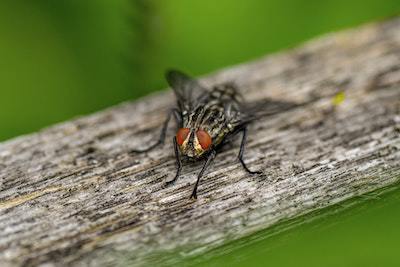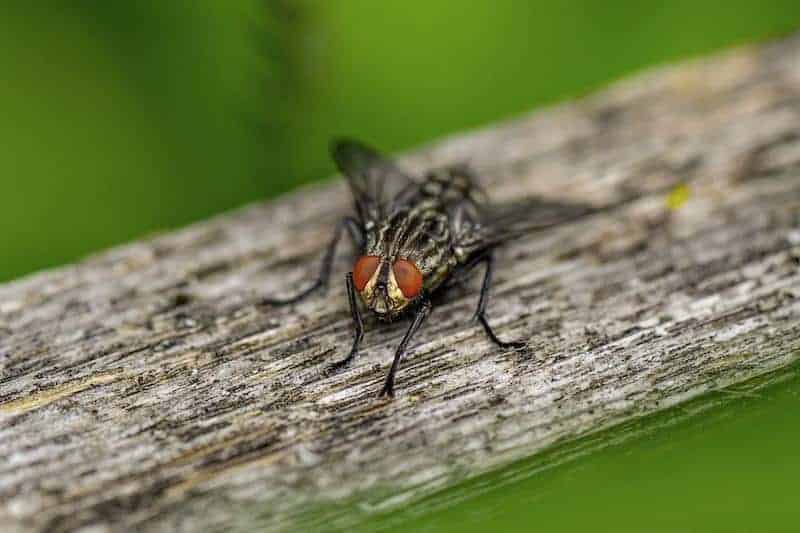How to Get Rid of Flies On Your Patio
Ahhhh, spring. Once April arrives, warm weather returns and the sun makes its glorious presence known. It’s like an instant hit of serotonin. Goodbye, seasonal depression! I’ll see you next year (sadly). This time of year, I absolutely love to be outside and enjoying my patio, with a cool drink in hand. The only thing that could ruin the pure bliss of these moments would be a bunch of annoying bugs or something. Oh…wait. It’s fly season, y’all. Even though spring is pure joy, this does mean that these annoying critters are flourishing in this warm weather, too. Flies seem to love hanging out around the exterior of my home and patio this time of year, and man, that can be mighty frustrating.
So, why are there flies on my patio, you may ask? I hate to be the bearer of bad news, but flies tend to be attracted to dirty places. These pests look for dirty places, especially near garbage to lay their eggs. If you routinely eat or drink on your patio and don’t make a habit to thoroughly clean away your crumbs or residue, you’re inviting flies to invade your sacred chilling space. Additionally, if you have pets and they make it a habit of relieving themselves near your patio, that could attract flies to your patio, as well.
Fortunately, there are many solutions to your fly problem so you can claim victory once more over your outdoor domain!

What Kind Of Flies Are On My Patio?
Even though many flies behave similarly, many different fly species may be infecting your patio area. Typically, homeowners tend to experience fungus gnats that adore outdoor plants, fruit flies that just can’t get enough of rotting food you’ve left behind, or the common housefly that just loves all things dirty and smelly.
According to the Amateur Entomologists’ Society, there are approximately 100,000 known species of flies throughout the world. Even though flies have a short lifespan (approximately 21 days), females can lay up to 900 eggs during that time. Yikes!
No matter what kind of fly situation you’ve got on your hands, they are all super annoying. Fortunately, any of these flies can be treated and prevented in similar ways, which involves cleaning and removing food and breeding sources, as well as purchasing fly control products.
How to Inspect Your Property For Fly Attractants
Flies are gross, plain and simple. They’re always looking for places to breed, and the dirtier and smellier the better. Adult flies are drawn to areas where they can lay eggs, such as compost piles, farms, roadkill, trash bins, and other areas where they can find organic matter.
Unfortunately, flies have a strong sense to detect odor, so even the smallest of food residue can bring in flies far and wide. If you like to entertain outdoors on your patio, there are more than likely traces of food or sugary residue from juices on the pavement or on your patio furniture. Flies will hone in on the smallest food available (this may be why there are ants on your patio, too)! The patio is now their sweet haven.
When checking for the source of your flies, of course, look for potential food sources as aforementioned, but also try to discover where the flies are laying eggs. In addition to feces and food, flies are also attracted to birdhouses and outdoor lighting. Whether you own your home or rent your home through a local property management company, it is important to inspect your property regularly for flies.
How to Get Rid of Flies on Your Patio
Fortunately, eradicating flies from your patio space isn’t difficult, just requires some cleaning and perhaps purchasing some fly control products.
- Step 1: You need to eliminate potential food sources and other materials from your patio that may be attracting flies. This means tidying your entire outdoor space. Wipe down your patio furniture with cleaning agents, and spray down your pavement to remove any sticky residue from food. It’s also a good idea to remove nearby pet waste, seal up your garbage can, and also take rotting wood to the nearby dump.
- Step 2: It’s fly bait time! Every month, scatter some fly bait on and around your patio, as well as other areas that the flies are attracted to. Be careful though, some of these products can be toxic to humans and pets, so don’t use them in areas where you directly serve food or somewhere that your pet can get into.
- Step 3: Use some sticky flytraps and hang them from tree limbs, in your garage, on birdhouses, or other areas that the flies are attracted to.
- Step 4: Spray insecticide around the exterior of your home. But like the fly bait, make sure you spray it in areas that won’t endanger your pets or children.
More About Fly Control Products
If you have an annual issue with flies, perhaps consider starting these treatment methods before the flies have a chance to build up in their populations. If you use a combination of fly bait, sticky flytraps, and insecticides, as well as removing food sources, the flies should be no match against you! For some serious fly infestations, you may need to work with a pest control company.
Using Insecticides
When it comes to using an insecticide, make sure you purchase a concentrated insecticide spray with a hand pump sprayer. You will dilute the insecticide with water, and then apply that solution to window frames, door frames, around porch lights, and other surfaces that you see flies resting. We recommend repeating this practice once per month during the spring and summer to help stop flies from traveling from your patio to making it inside your home.
Using Flytraps
Flytraps are also a great way of controlling your outdoor fly population. We recommend using flytraps when you have a medium to a high level of infestation. So how do fly traps work? They’re a great alternative to using insecticides because they work by creating an area that is attractive for females to lay eggs. However, once they are inside the trap, the flies are unable to escape. When placing your flytraps, make sure to put them at least 30 feet from the area you are trying to protect from the flies.
Using Fly Baiting
And last but not least, fly baiting is also a great way to remove fly populations from your patio. Baiting for flies is typically done when the source of the flies cannot be completely removed, such as being on a farm, near dumpsters, or near composting areas.
According to Do On My Own, fly baits typically have a food attractant and a pheromone attractant to eliminate flies along with an insecticide to eliminate flies once the bait has been eaten. Fly baits can be mounted on fences, walls, or other areas where flies are a major problem.
Natural Remedies to Eradicate Patio Flies
If you’re not into using chemical products to remove or prevent flies, never fear! There are some natural remedies you can try that will prevent flies from swarming your outdoor haven. After you’ve cleaned up your patio space and removed food sources, there are a few tricks you can use to keep the flies away.
Flowers and herbs are natural fly repellants, especially basil, bay leaves, catnip, lavender, and marigolds. You can also use a mixture of vinegar and dish soap as a natural flytrap. You pour the mixture into a cup and then cover it tightly with plastic wrap and then poke holes large enough for the flies to enter. The flies will become attracted to the scent, but then won’t be able to escape from the bowl and the mixture.
Another handy fly trick you could try is mixing cayenne pepper with water and spritz that mixture around your outdoor spaces. Flies are not a fan of that scent and will stay away.
Related Questions
Can essential oils help prevent outdoor flies? Flies are not fans of essential oils. Because of this, essential oils can be an excellent deterrent for flies. You can use peppermint, lemongrass, eucalyptus, lavender, and tea tree oil as the best choice for bug repellant. In fact, this method may also help you get rid of mosquitos naturally! After cleaning your outdoor area, then just spray an essential oil mixture around the area.
What kinds of lights repel flies? Like uncleanliness and smells, flies also are very attracted to white lights. Like many other flying insects, they are phototactic, which means their eyes have a special mechanism to see patterns in ultraviolet light. To prevent swarms of flies or other flying insects to your patio, it’s best to replace your outdoor lights with warm orange or yellow lights, as this will less likely attract flies.
Do flies bite? Flies can bite, and when they do, they bite for blood for nutrition purposes. Most bites are more annoying than actually threatening. However, some fly bites can hurt and leave bumps or blisters, depending on the species of fly that bit you. Some fly bites can even transmit diseases to humans.
Common biting fly species in the United States include the sand fly, the tsetse fly, the deer fly, black flies, and stable flies. Most of these fly bites can be treated with ice and topical steroidal creams. However, some bites can come with headaches, nausea, and fever, and it’s best to visit your local health care provider if these symptoms arise following a fly bite.

